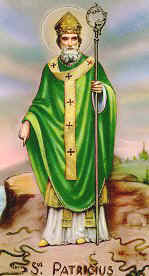Saint Patrick
d. 17 March ca. 461
 Saint
Patrick was born about 373 AD in either Scotland (near the town of Dumbarton) or in
Roman Britain (the Romans left Britain in 410 A.D.). His real name is believed to be
Maewyn Succat (he took on Patrick, or Patricus, after he became a priest). It was a
time of tumult: the hordes of Goths and barbarians from Northern Europe began
hammering at the door of Rome. Rome summoned her soldiers home from Britain. This was
the signal for Irish raiders to harass the well-stocked towns of the Romans in Britain. On
one of these raids, Patrick, at the age of 16 years, was carried away as a slave.
Saint
Patrick was born about 373 AD in either Scotland (near the town of Dumbarton) or in
Roman Britain (the Romans left Britain in 410 A.D.). His real name is believed to be
Maewyn Succat (he took on Patrick, or Patricus, after he became a priest). It was a
time of tumult: the hordes of Goths and barbarians from Northern Europe began
hammering at the door of Rome. Rome summoned her soldiers home from Britain. This was
the signal for Irish raiders to harass the well-stocked towns of the Romans in Britain. On
one of these raids, Patrick, at the age of 16 years, was carried away as a slave.
Saint Patrick had grown up in a Christian family. His father was a deacon and his grandfather a priest. Surely, he was nourished with all the Christian love and grace a child can receive. However, he writes: "I was then about sixteen years of age. I did not know the true God. I was taken into captivity to Ireland with many thousands of people - and deservedly so," "I did not believe the living God, nor did I so from my childhood, but lived in death and unbelief"
Now he turned to God for help. After six years, he either escaped or was freed, made his way to a port 200 miles away, and there persuaded some sailors to take him onto their ship. He returned to his family much changed, and began to prepare for the priesthood, and to study the Bible. Later he was ordained as a deacon, then a priest and finally a bishop, spending part of his time in continental Europe.
Around 435, Patrick was commissioned, perhaps by bishops in Gaul and perhaps by the Pope, to go to Ireland as a bishop and missionary. Four years earlier another bishop, Palladius, had gone to Ireland to preach, but he was no longer there. Patrick made his headquarters at Armagh in the North, where he built a school, and had the protection of the local monarch. From this base he made extensive missionary journeys, with considerable success. It is said that Patrick had an unusually winning personality, and that helped him gain converts. He used the shamrock, which resembles a three-leafed clover, as a metaphor to explain the concept of the Trinity. To say that he single-handedly turned Ireland from a pagan to a Christian country is an exaggeration, but is not far from the truth.
Legend has it that Saint Patrick drove all the snakes out of Ireland - that they all went into the sea and drowned. In many old pagan religions serpent symbols were common, and possibly even worshipped. Driving the snakes from Ireland was probably symbolic of putting an end to that pagan practice.
Almost everything we know about him comes from his own writings. He has left us an autobiography (called the Confession), a Letter to Coroticus in which he denounces the slave trade and rebukes the British chieftain Coroticus for taking part in it, and the Lorica (or "Saint Patrick’s Breastplate"), found today in many hymnals.
According to tradition St. Patrick was buried in the same grave as St. Bridget and St. Columba, at Downpatrick, County Down. Another legend says St. Patrick ended his days at Glastonbury and was buried there. The Chapel of St. Patrick still exists as part of Glastonbury Abbey.
Acknowledgements:
Text adapted from James Kiefer's Christian Biographies,
Who Was Saint
Patrick?
Image from Saint
Charles Borromeo Church